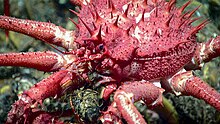| Neolithodes agassizii | |
|---|---|

| |
| Dorsal view of Neolithodes agassizii | |

| |
| Neolithodes agassizii eating a mussel | |
| Scientific classification | |
| Domain: | Eukaryota |
| Kingdom: | Animalia |
| Phylum: | Arthropoda |
| Class: | Malacostraca |
| Order: | Decapoda |
| Suborder: | Pleocyemata |
| Infraorder: | Anomura |
| Family: | Lithodidae |
| Genus: | Neolithodes |
| Species: | N. agassizii |
| Binomial name | |
| Neolithodes agassizii (Smith, 1882) | |
| Synonyms | |
|
Lithodes agassizii Smith, 1882 | |
Neolithodes agassizii is a species of king crab native to the Western Atlantic. They live at depths of 200–1,900 metres (660–6,230 ft), and have been found as far south as Rio de Janeiro, as far north as latitude 36°, and near the Equator. It has been found in the southwestern Caribbean Sea as well as the Gulf of Mexico.
Appearance
N. agassizii has a pyrifrom carapace; the largest adult specimen at the time of description, a female, had a carapace measuring 123 mm (4.8 in) in postrostral length and 117 mm (4.6 in) in width. Whereas its carapace is about 9⁄10 as wide as it is long in adults, this is closer to 8⁄10 in juveniles. The spines around the margins of its carapace are slightly larger than those on its dorsal surface, and between these marginal spines are tubercles. Its rostrum is very short. Its chelipeds feature little spination and are similar in length, but the right is stouter than the left. Its rear walking legs – the longest pair – are nearly three times as long as the carapace width, and all of its dactyli are slightly curved and armed with small, sharp spines. Its underside features a symmetrical abdomen in juveniles, but in adults, there is a noticeable asymmetry in the third, fourth, and fifth segments – its left side is well-developed at the expense of the right side. Its second abdominal segment bears prominent spines.
See also
- Neolithodes grimaldii, a species which small specimens of N. agassizii may be confused for
- Neolithodes indicus, a species originally misidentified as N. agassizii
References
- ^ Smith, Sidney Irving (June 1882). "Reports on the results of dredging under the supervisión of Alexander Agassiz, on the east coast of the United States during the summer of 1880, by the U.S. Coast Survey Steamer "Blake", Commander J.R. Bartlett, U.S.N., commanding" (PDF). Bulletin of the Museum of Comparative Zoology, at Harvard College. 10 (1): 1–108. Retrieved 20 October 2024 – via the Natural History Museum of Los Angeles County.
- De Grave, Sammy (25 July 2022). "Neolithodes agassizii (Smith, 1882)". WoRMS. World Register of Marine Species. Retrieved 21 October 2024.
- Felder, Darryl L.; Álvarez, Fernando; Goy, Joseph W.; Lemaitre, Rafael (2009). "Decapoda (Crustacea)". In Felder, Darryl L.; Camp, David K. (eds.). Gulf of Mexico: Origin, Waters, and Biota. Vol. 1, Biodiversity. Texas A&M University Press. p. 1069. ISBN 978-1603440943. LCCN 2008025312.
- de Almeida Alves-Júnior, Flavio; et al. (27 July 2018). "New Records of Two Deep-Sea Crabs of the Family Lithodidae Samouelle, 1819 (Crustacea: Decapoda) in the Southwestern Atlantic". Thalassas. 35: 117–122. doi:10.1007/s41208-018-0098-6. S2CID 133766601.
while Neolithodes only has two species recorded from Brazil, Neolithodes agassizii (Smith, 1882) from Bahia to Rio de Janeiro
- Pohle, Gerhard W. (1992). "First Canadian record of Paralomis bouvieri Hansen, 1908 (Decapoda: Anomura: Lithodidae), infected by the rhizocephalan Briarosaccus callosus (Cirripedia: Peltogastridae) and carrying a hyperparasitic cryptoniscinid isopod (Epicaridea)". Canadian Journal of Zoology. 70 (8): 1625–1629. doi:10.1139/z92-224 – via ResearchGate.
- Macpherson, Enrique (1988). "Revision of the family Lithodidae Samouelle, 1819 (Crustacea: Decapoda: Anomura) in the Atlantic Ocean" (PDF). Monografías de Zoología Marina. II: 33–37. ISSN 0213-4020. Archived (PDF) from the original on May 14, 2020 – via the Natural History Museum of Los Angeles County.
- Martínez-Campos, Bibian; Dueñas, Luisa F.; León, Jorge; Puentes, Vladimir (2023). "Presence of the deep-sea lithodid crabs Neolithodes agassizii and Paralomis pectinata (Anomura, Lithodidae) in the Colombian Caribbean Sea". Marine Reports. 2 (1): 1–8. doi:10.5281/zenodo.8050512. ISSN 2822-5155.
- Wicksten, Mary K.; Packard, Jane M. (September 2005). "A qualitative zoogeographic analysis of decapod crustaceans of the continental slopes and abyssal plain of the Gulf of Mexico". Deep Sea Research Part I: Oceanographic Research Papers. 52 (9): 1745–1765. Bibcode:2005DSRI...52.1745W. doi:10.1016/j.dsr.2005.04.006.
External links
 Media related to Neolithodes agassizii at Wikimedia Commons
Media related to Neolithodes agassizii at Wikimedia Commons Data related to Neolithodes agassizii at Wikispecies
Data related to Neolithodes agassizii at Wikispecies
| Taxon identifiers | |
|---|---|
| Neolithodes agassizii | |
| Lithodes agassizii | |
This Anomura article is a stub. You can help Misplaced Pages by expanding it. |
